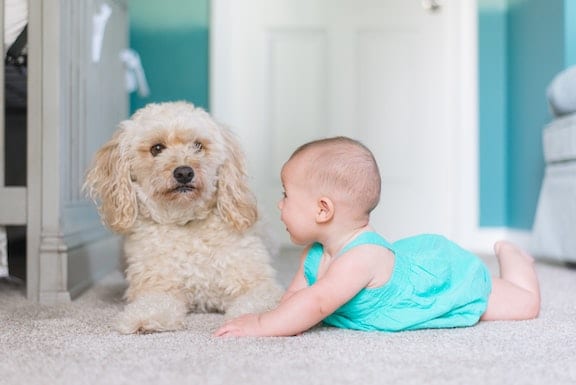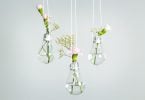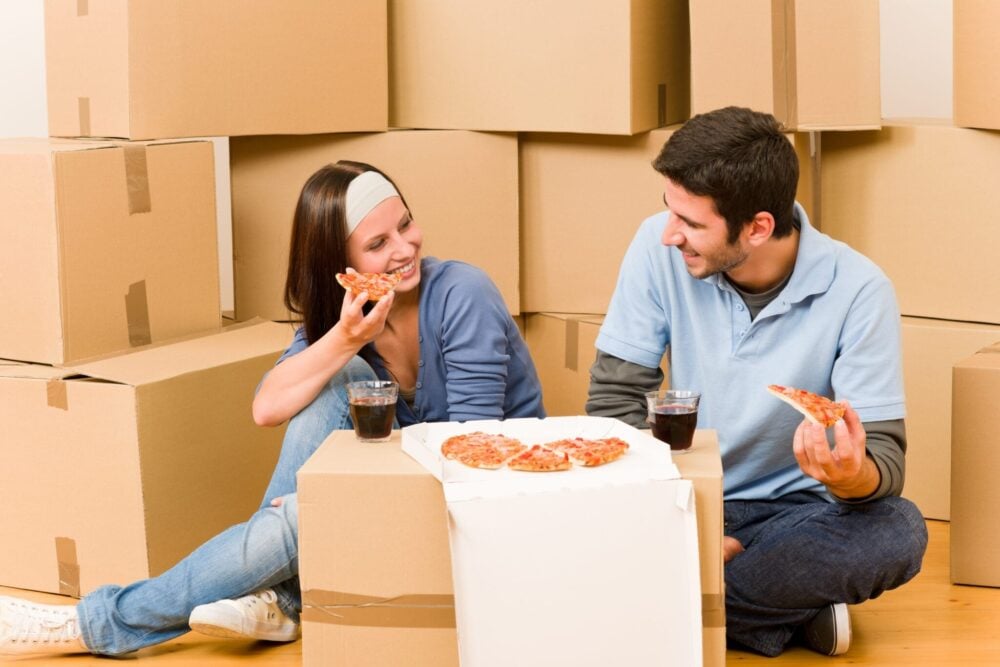Moving with a baby requires a lot of creativity. How long is he willing to be carried around in the snuggly while you pack? When will you sneak in her naps? There’s one more really important thing to consider before you start settling into your new home:
So if you are moving with a baby, what will you need to babyproof in your new home?
As with just about everything, advance preparation before the move is key. Here, we’ll identify some of the key things you can do before you move in to keep your baby safe.
Examine the home to assess what will need to be addressed immediately
Identify the big-ticket things like large staircases, a pool or hot tub, a balcony with insufficient protection, or fireplaces. These things require equipment and accessories to protect your baby, so order what you need well in advance. If you are moving into a house built before 1978 (when lead paint was banned), ask your real estate agent or landlord about lead paint abatement. Older homes often had lead paint, which can flake off and end up in babies’ mouths. If there is concern about lead, have the paint cleaned up and sealed by a professional.
Schedule any installations or updates to happen before you start unpacking
If paint is a concern, have the painters come far enough in advance that things will be dry when you arrive. If you need to build a fence around the pool, modify the built-in fireplace, or make some upgrades to your balcony, work with your real estate agent to have the work done ahead of time. Unpacking is hard enough with a baby — you don’t need to also be working around tools and equipment!
Order outlet covers and cabinet closures
Count the number of low cabinets, drawers, and electrical outlets that will need closures and covers and order a few extra. You can install these quickly and easily on move-in day. Then you can rest easy that your baby won’t discover anything in your empty cabinets. As you are probably discovering, babies are quite curious!

Think in terms of “baby height” when unpacking
Anything and everything that is within reach are guaranteed to be explored. Be sure you store vitamins and supplements well out of reach in an upper cabinet with a closing latch. Keep cleaning products in a locked closet, or in an area that is completely off-limits to a roaming baby. In the kitchen, place your countertop appliances well out of reach — watch out for those cords! And when you start setting up your bookcases and other shelving, remember that anything you put on the lower shelves is bound to get pulled off. So choose wisely.
Put effective baby gates and the bottom and top of staircases
Do a little research to find out what baby gates are actually effective. Remember that a determined crawling baby will try to push the gate, or even use it as a tool to stand up. Make sure your gates are up for the job and will stay in place. Gates can also be useful for keeping baby out of rooms that you aren’t able to fully babyproof, like your home office or the laundry room.
Babyproof your utilities
Make sure that your water heater has a scald guard set to no more than 120 degrees Fahrenheit. Install knob covers on your stove if the cooktop dials are within reach — especially if you have a gas stove. And if you use a wood stove, gas fireplace, or other similar heat sources, make a plan for how to keep your baby safe around the fire. Babyproofing a woodstove is no easy feat, so start discussing this well in advance of moving day.

Anchor tall furniture and electronics
Your television, bookshelves, tall dressers, and even plant stands can seem like a great climbing tool for a baby just learning how to walk. A lot of furniture comes with hardware to anchor it to the wall, so be sure to use it! Even if you think your dresser is heavy enough to prevent a tip-over, it’s always better to be safe. Your television should have brackets on the back to secure it to the wall, too — those bright flashing pictures are oh-so-alluring to little ones. You can often add wall mounting services to your moving package, so make sure you include it in your estimate!
Put nonslip pads under all area rugs
This baby proofing tip is partially for your little one and partially for you. Nobody wants to be falling over with a baby in their arms, and no little walker wants to get tripped up on a slippery rug! Wherever you have area rugs, make sure they are equipped with nonslip pads to keep them in place. Then walk through your home with an eye towards any other slippery surfaces that might need to be secured. Making a new home baby-proof requires shifting your vision to toddler view!
Put bumpers or padding on all furniture corners
As soon as your furniture is brought into the house, get out your handy corner bumpers and get them installed on coffee tables, end tables, kitchen tables, or anything else with a corner that could cause injuries. If your baby isn’t crawling or walking yet, you have a little more time. But don’t delay too long — that crawling stage happens so quickly, and you’ll be busy with lots of other things getting settled in your new home!
Moving with a baby is bound to be a challenge. Planning ahead and child-proofing your move can make it easier! Let us help you smooth out your moving day with a team of dependable movers. Get a guaranteed moving quote quickly and easily!








